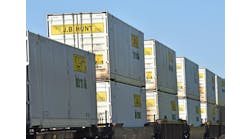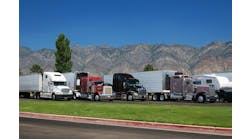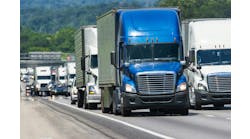Users of the transportation system need to help dispel some of the myths about freight transportation and the developing infrastructure crisis that will affect freight flows, says Jean Goodwin, executive vice president and general counsel for the American Association of Port Authorities (AAPA www.aapa-ports.org). Speaking at the 52nd annual summer conference of SMC3, she emphasized that there are 180 deep-draft ports in the United States covering both "blue states" and "red states." The issues facing ports, she said, are non-partisan.
Ports are dynamic transportation hubs, said Goodwin, and the US ports are trying to keep up with the demands of global trade while attempting to be a catalyst for family-wage jobs. Still, she said, the AAPA and other supporters may only get 30 to 60 seconds to make their case with key government officials. You need to know what you are going to say when you see that presidential candidate stumping in your backyard and you get your 30 to 60 seconds, she told the transportation executives in the audience.
Mythbuster number one. "When you’ve seen one port, you’ve seen one port," said Goodwin. No two ports are alike. The physical layout, types of equipment they use, the markets they serve, and the way they’re financed and governed make it difficult to categorize ports under a general description. The common thread connecting them is the need to develop waterfront property for shipping and cargo handling purposes. All of the AAPA members are public agencies with elected or appointed boards and professional port staffs. They can be in state, county, city or special districts and may even be in a bi-state district, so economic development is often focused on issues other than maritime development. (Goodwin offers a favorite example in the Rock and Roll Hall of Fame and Museum in Cleveland, Ohio which was built on port property and with port authority support.)
On the landside, AAPA works to support ports dealing with a very decentralized government structure. Between 1946 and 2003, the US port authorities invested $27 billion in capital projects to enhance facilities. "We are spending over $2 billion a year to continue to do that," said Goodwin.
Mythbuster number two. On the waterside, the federal government controls development of federal navigation channels. Maintenance dredging to keep access channels at authorized depths is funded by a harbor maintenance fee which is paid into the Harbor Maintenance Trust Fund. New projects are funded by a combination of federal and local sponsorship, and the local portion can be as much as 60% of the project.
Dredging is not a top-of-mind issue when projects are planned and with much of the money sitting in the trust fund, cargo is paying into the fund in the form of user fees but unlike the highway trust fund, there is no direct connection between the amount appropriated for projects and the amount collected. Users have essentially prepaid for services they’re not getting, comments Goodwin.
When you talk about dredging to your congressmen, their eyes glaze over, she continues. There’s a perception that all ports want infrastructure that only a few are going to be able to use, and that’s not the case. While maintenance dredging is falling behind, ships are getting bigger. Goodwin offered a localized example for the attendees. Not far from the meeting site in Myrtle Beach, SC is the port of Georgetown, SC. That port isn’t getting the money it needs for maintenance dredging, said Goodwin, and because of that, the cost of construction in Myrtle Beach is higher. Goods that could be shipped to a port 10 miles from a construction site must land farther away and be brought in by truck. That’s good for the motor carriers present, she quipped, but moving those goods an additional 120 miles by truck is an unnecessary expense that gets added to the construction costs.
Mythbuster number three. Addressing the issue of short sea shipping, Goodwin suggested the perspective is skewed. People talk about getting trucks off the road, she said. The real issue is moving the point where a truck would pick up the cargo out of a congested region and into a less congested area where it can move more efficiently.
AAPA supports short sea shipping, said Goodwin, but the mode faces some challenges. One is the harbor maintenance tax. International cargo that arrives at one US port and is transshipped to another US port pays twice. Another issue is the chicken-and-egg problem, she continued. Often, the infrastructure and the services aren’t there at the port, and no one wants to invest in building it unless they know the business is going to be available. Someone has to stick their neck out, said Goodwin, possibly with some federal support.
Mythbuster number four. Cargo volume growth projections are staggering, Goodwin pointed out. There are about 1,000 ocean-going vessels calling on US ports, accounting for a total of 24,000 vessel calls per year. From 1998 to 2005, the number of international containers rose from 15 million to 26 million. If that trend continues, the US ports don’t have the infrastructure to meet the growth. And, she noted, it’s not just a West Coast problem. With the expansion of the Panama Canal, which is slated to be complete in less than seven years, US East Coast and Gulf Coast ports will see increased volumes as well.
Bigger ships don’t just need deeper channels to operate, they also need bigger cranes, longer docks, and additional shoreside equipment to handle the cargo. Access will be critical to ports, including landside access. Here, the ports are working with railroads, and they are seeing progress. But railroads are private entities. Highway connections and capacity will be a major factor, and that won’t be as easy to resolve. (See Congestion Takes a Holiday, pg. 23) Some issues can be as simple as installing a left-turn signal to improve traffic flow, says Goodwin, but it’s difficult to get the issues resolved when they are subject to local funding.
Here, Goodwin called on attendees to help in the local communities where they operate. It’s important to cultivate an understanding of the importance of freight and goods movement at the local level, she pointed out.
Adding to the challenges of funding dredging and harbor maintenance, keeping the economic development focus on cargo (when developers are eyeing waterfront property), funding and building infrastructure to support efficient freight flows, the ports face increasing pressure on security.
Mythbuster number five. You want to build public awareness of security needs, said Goodwin, because you want public support for funding. But you don’t want to create an atmosphere of fear. The general public understands airport security because they fly, said Goodwin, but they don’t understand port security and they only see ports when something goes wrong—like the West Coast port lockout in 2002, hurricane Katrina, or the DP World purchase of P&O Ports.
There is confusion over some of the basic terminology, said Goodwin, and this can translate into some very negative attitudes and rules. Chief among the concerns is a call for 100% inspection of cargo containers. Goodwin offered brief explanations of three terms that are often misunderstood.
Screening involves looking at data on where a shipment is coming from, who’s shipping it, how it’s being handled, etc. That’s typically done well in advance of the goods moving.
Scanning is actually passing the container through a device to check the contents and detect threats like radiation. More scanning is being done at foreign ports before the cargo is loaded aboard a ship bound for the US. The technology is capable, says Goodwin, but not everyone has it.
With scanning, there is also an issue of manpower. As with an airport baggage scan, there is very little value in collecting images if no one is looking at them and interpreting them, she pointed out. Scanning cargo containers also means having skilled people available to interpret those images. On the inbound side in the US, some of the smaller ports have encountered issues with Customs and Border Protection (CBP) not having sufficient personnel to staff the operation beyond eight hours.
Inspection, Goodwin pointed out, means physically opening the container and looking at the cargo. You can’t physically open every container coming to America, she cautioned. So, language is important, and Goodwin and audience members agreed that the general public is less aware of the distinctions. The situation has been further exacerbated by the general media getting it wrong, she added.
The transportation industry has some work to do in understanding the infrastructure challenge, funding, and political issues surrounding port operations, maintenance, and expansion. But the industry can also help mold some public perceptions on the impact delays and inefficiency will have as well as the positive role freight plays in local, regional, and the national economies. And, if ports are to avoid becoming major bottlenecks, both the industry and the general public need a basic understanding of what is reasonable on security.


